 |
 |
 |
| |
Histologic Outcomes in Hepatitis C-Infected Patients With Breakthrough or Relapse to Interferon-Based Treatments: there was a positive correclation between viral response and improved fibrosis
|
| |
| |
EASL April 23-26 2009
Reported by Jules Levin
Paul Pockros, MD1; Fayez M. Hamzeh, MD, PhD2; Paul Martin, MD3; Ellen Lentz, PhD2; Anna Lok, MD4
1Scripps Clinic, La Jolla, CA; 2Roche, Nutley, NJ; 3Miller School of Medicine, University of Miami, Miami, FL; 4University of Michigan Medical Center, Ann Arbor, MI
This study was supported by Roche
INTRODUCTION
During therapy for hepatitis C virus (HCV), patients who do not achieve undetectable HCV RNA levels with interferon-based therapies and patients who experience treatment relapse or breakthrough are considered treatment failures.
Histologic improvements have been observed in patients who did not achieve undetectable HCV RNA levels1 and in patients who relapsed following initial viral clearance.2
CONCLUSIONS
There was a positive correlation between the degree of virologic response and mean changes in the Metavir NIF and fibrosis scores.
Patients with SVR had the greatest histologic benefits. Patients who experienced an initial virologic response but later became HCV RNA detectable (relapsers, and relapsers and breakthroughs combined) also had significantly greater responses in both NIF and fibrosis scores than virologic nonresponders.
Histological improvement may occur with HCV therapy even in the absence of SVR.
OBJECTIVE
The objective of this analysis was to assess the histologic response to interferon-based therapies based on changes in the Metavir necroinflammatory (NIF) and fibrosis scores in patients with varying degrees of virologic response.
METHODS
Patients
Patients (HCV genotypes 1-6) who had both baseline and follow-up liver biopsies from 6 Phase II/III interferon-based clinical trials were pooled and included in the analysis.3-8
Four of the 6 studies (NV15489, NV15495, NV15496, and NV15497) were open-label, randomized, multicenter, Phase II/III studies comparing different dose regimens of peginterferon alfa-2a monotherapy with interferon alfa-2a monotherapy in interferon-naÏve patients with chronic hepatitis C.5-8
The remaining 2 studies (NV15801 and NV15942) were randomized, multicenter, Phase III studies of interferon-naÏve patients; the first compared peginterferon alfa-2a/ribavirin combination therapy to interferon alfa-2b/ribavirin combination therapy and the second compared the efficacy of a 24 week vs. 48 week regimen of peginterferon alfa-2a/ribavirin.3,4
Patients included in this analysis received standard interferon, peginterferon alfa-2a, or peginterferon alfa-2a plus ribavirin.
Biopsies from all patients were evaluated in a blinded fashion by a single pathologist.
Virologic Response Category
Patients were grouped into the following categories based on the degree of virologic response:
- Sustained virologic response (SVR): undetectable HCV RNA at 24 weeks
post end of treatment
- Relapsers: undetectable HCV RNA at end of treatment but detectable at 24 weeks post end of treatment
- Breakthroughs: undetectable HCV RNA during treatment but detectable at end of treatment
- Nonresponders: HCV RNA detectable throughout treatment (never became undetectable).
Histologic Outcome
Histologic outcome was determined based on changes in the Metavir NIF and fibrosis scores from baseline to 24 weeks post end of treatment.
_ Patients were classified with respect to the NIF activity grade and fibrosis
stage as either:
- Improved (decrease of ≥1 categories from baseline to follow-up)
- Stable (no change in category from baseline to follow-up)
-- Worsened (increase of ≥1 categories from baseline to follow-up).
RESULTS
Patient Demographic and Baseline Characteristics
In total, 1586 patients were included in the analysis.
The patient demographic and baseline characteristics by virologic response
category are summarized in Table 1.
The majority of patients were white (86%), male (69%), >40 years of age (59%),
with HCV genotype 1 (64%), baseline HCV RNA levels >800,000 IU/mL (56%),
and baseline ALT levels ≤3°- ULN (61%).
>70% of the patients received either peginterferon alfa-2a monotherapy, or
peginterferon alfa-2a/ribavirin combination therapy. The mean duration of
treatment was 45 weeks.
Metavir NIF
There was a positive correlation between the degree of virologic response and mean change in NIF scores from baseline, with SVR patients experiencing the greatest decrease in NIF score, followed by relapsers and patients with breakthrough (-0.84, -0.24, and -0.14, respectively) (Figure 1).
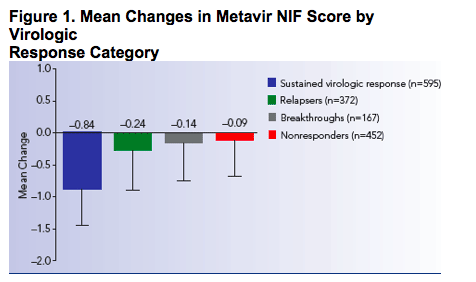
In the overall response categories, there was a significant positive correlation between the degree of virologic response and NIF status (P<.001) (Table 2).
- Significantly greater benefits in NIF scores were observed in relapsers as well as in relapsers and breakthroughs combined compared with nonresponders (P<.0001 for both comparisons).
-- The changes in NIF score were not significantly different between breakthroughs and nonresponders (P=0.22)

Metavir Fibrosis
A positive correlation was also observed between the degree of virologic response and mean change in Metavir fibrosis scores from baseline, with SVR patients experiencing the greatest decrease in fibrosis score, followed by relapsers and patients with breakthrough (-0.29, -0.17, and -0.02, respectively) (Figure 2).
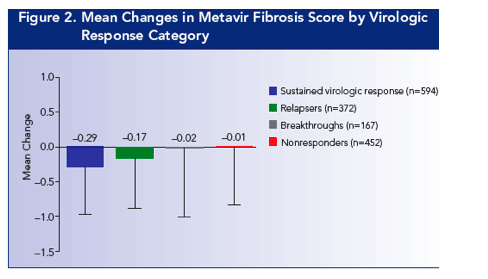
In the overall response categories, there was a significant positive correlation between the degree of virologic response and change in fibrosis status (P<.001). The trend tests for the correlation between virologic response and fibrosis improvements (P<.017) and fibrosis worsening (P<.001) were also significant (Table 3).
- Compared with nonresponders, relapsers (P<.0001) as well as relapsers and breakthroughs combined (P<.0005) experienced significantly greater benefits in fibrosis scores.
- The changes in fibrosis score were not significantly different between breakthroughs and nonresponders (P=0.38)
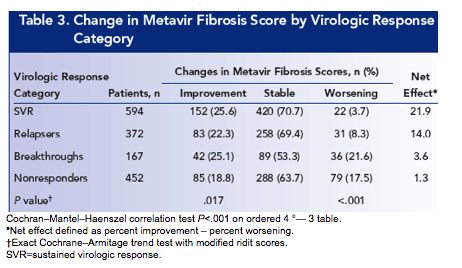
The correlation between the degree of virologic response and histologic benefits observed in the overall population was also consistent across the subgroups of patients who received peginterferon alfa-2a monotherapy and peginterferon alfa-2a/ribavirin combination therapy.
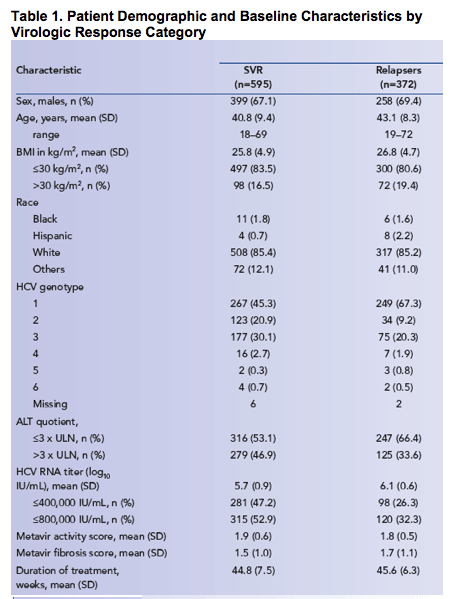
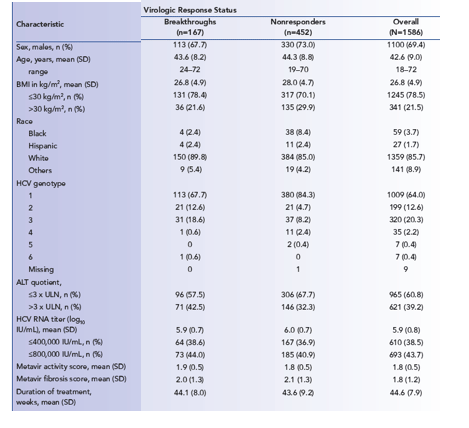
REFERENCES
1. Lissen E, Clumeck N, Sola R, et al. Histological response to pegIFNα-2a (40KD) plus ribavirin in HIVhepatitis C virus co-infection. AIDS. 2006;20:2175-2181.
2. Everson GT, Balart L, Lee SS, et al. Histological benefits of virological response to peginterferon alfa-2a monotherapy in patients with hepatitis C and advanced fibrosis or compensated cirrhosis. Aliment Pharmacol Ther. 2008;27:542-551.
3. Fried MW, Shiffman ML, Reddy KR, et al. Peginterferon alfa-2a plus ribavirin for chronic hepatitis C virus infection. N Engl J Med. 2002;347:975-982.
4. Hadziyannis SJ, Sette H, Jr., Morgan TR, et al. Peginterferon-α2a and ribavirin combination therapy in chronic hepatitis C: a randomized study of treatment duration and ribavirin dose. Ann Intern Med. 2004; 140:346-355.
5. Reddy KR, Wright TL, Pockros PJ, et al. Efficacy and safety of pegylated (40-kd) interferon α-2a compared with interferon α-2a in noncirrhotic patients with chronic hepatitis C. Hepatology. 2001; 33:433-438.
6. Heathcote EJ, Shiffman ML, Cooksley WG, et al. Peginterferon alfa-2a in patients with chronic hepatitis C and cirrhosis. N Engl J Med. 2000;343:1673-1680.
7. Pockros PJ, Carithers R, Desmond P, et al. Efficacy and safety of two-dose regimens of peginterferon alpha-2a compared with interferon alpha-2a in chronic hepatitis C: a multicenter, randomized controlled trial. Am J Gastroenterol. 2004;99:1298-1305.
8. Zeuzem S, Feinman SV, Rasenack J, et al. Peginterferon alfa-2a in patients with chronic hepatitis C. N Engl J Med. 2000;343:1666-1672.
|
| |
|
 |
 |
|
|